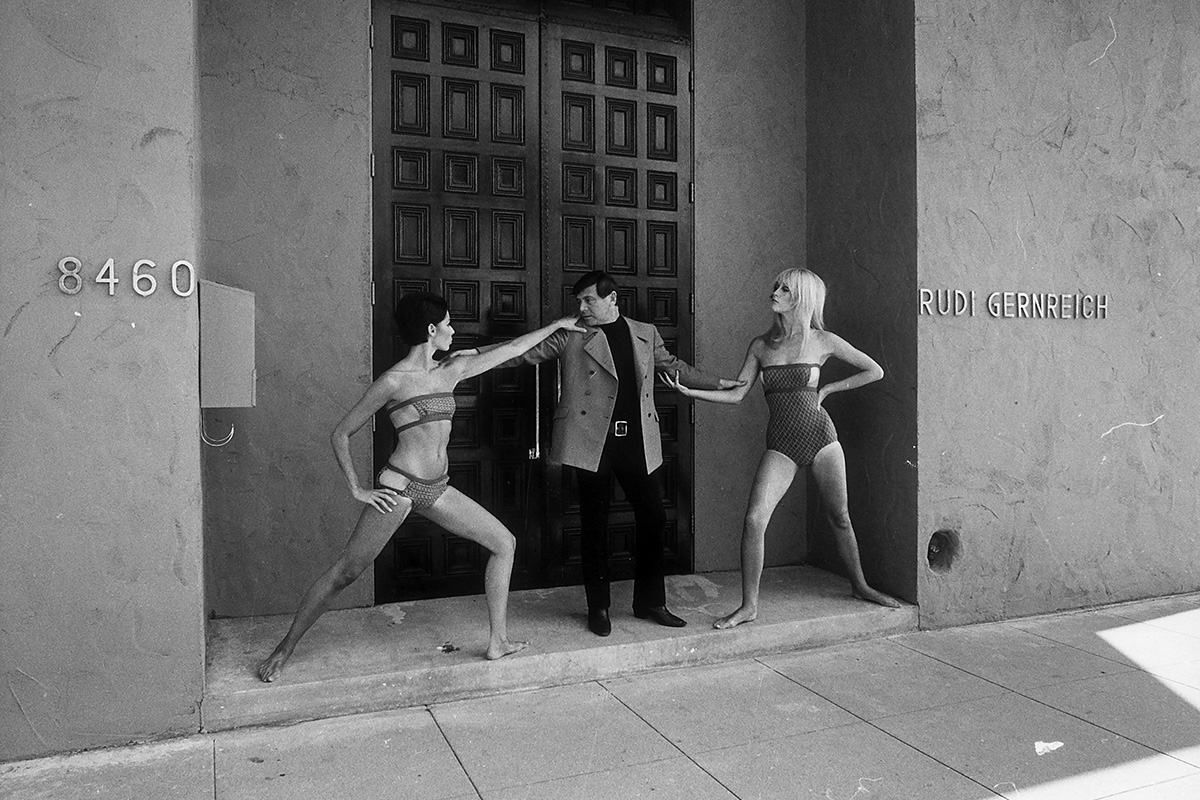When we think of fashion, we think of clothing; but do we stop to think just where those pieces of clothing came from or how they were born?
I can personally say that I never stopped to think about it — until now. This summer, I was fortunate enough to have visited a traveling exhibit at the Phoenix Art Museum titled “Fearless Fashion: Rudi Gernreich.” As someone who considers themself to be somewhat of a novice when it comes to the world of high fashion, I had no idea what to expect. Contrary to my low expectations, I was left buzzing with delight over the beautiful piece of Jewish, queer history that I serendipitously stumbled upon one afternoon. I seriously haven’t stopped thinking about it since.
So, who exactly was Rudi Gernreich?
Rudi Gernreich was a queer, Austrian-born fashion designer who made his mark in America by changing how people, especially women, viewed and utilized fashion. Born in Vienna in 1922, Rudi learned about high fashion and fabrics from his aunt, Hedwig Müller, who owned a dress shop. However, unable to let his curiosity soar for long, in 1938, Gernreich and his mother fled to Los Angeles, California, as Jewish refugees from Austria to escape Nazi Germany. There, he studied art at the Los Angeles Art Center School from 1941 to 1942. Using skills from his time as a student, he began working on costume design in Hollywood, but hated it.
Wanting to break out of the costume design world, and as a former dancer, he found himself working for the Lester Horton Dance Company. During this time, he intimately saw what clothing does to the body, sparking his interest in modern fashion design. However, with a distaste for the rigid rules of high fashion dictated by Paris at the time, he broke away from the mainstream to design his line of clothing. This bold move led him to become known as an avant-garde designer who broke many designer rules.
Rudi wanted fashion to be comfortable and to work for the body — never against it. He was against the notion that the human body, especially women’s bodies, should be sexualized. Instead, he wanted to design clothing that celebrated it. “To me, the only respect you can give to a woman is to make her a human being,” Rudi was quoted saying in “Rudi Gernreich: Fashion Will Go Out of Fashion.” “A totally emancipated woman who is totally free.”
Gernreich believed in the concept of breaking down gender roles. He aimed to create a unisex line, predicting that people would no longer distinguish between the masculine and the feminine in the future and instead seek comfortable and practical clothing. To no longer restrict the body, in 1952, he launched the first swimsuit without a built-in bra. At this time, bathing suits had a rigid underwire, but his design used elastic wool that clung to the body rather than suffocating it under uncomfortable wires and padding.
This bathing suit trend took an iconic turn in 1964 when Rudi invented the first topless bathing suit, which he called the Monokini. Additionally, in 1974, he made the first-ever thong bikini in response to California banning nude beaches, making Rudi one of the most provocative designers during this time. There was a strong public reaction to these bathing suits, particularly the Monokini. Proving Rudi’s statement that society put too much sexual emphasis on the human body, the Vatican denounced it, and it was outlawed in Holland, Denmark, and Greece. Women in the U.S. were also arrested for wearing the Monokini, a “public indecency” phenomenon that still occurs in some countries today.
While Rudi was making his mark on the fashion world to liberate women and their bodies, he was also making a significant impact on the LGBTQ community.
Like many other well-known fashion designers, Gernreich, unfortunately, wasn’t publicly out during his lifetime and kept his sexual orientation hidden from the press and the public eye. However, Rudi was heavily involved in movements in the Los Angeles area to de-stigmatize and create safer spaces for the LGBTQ community. In 1950, he became romantically involved with a man named Harry Hay, and together they formed a secret society to support gay men, which was called the Mattachine Society. This society had roots in LA, but other urban areas also began to develop their own groups. With the motivation to protect gay men from isolation and violence, the Mattachine Society was one of the earliest gay rights groups in the United States on record.
Later in 1953, Gernreich met and fell in love with Oreste Pucciani, a UCLA French philosophy professor. They never made their relationship public, but Pucciani was also critical for the LGBTQ movement in Los Angeles during this time. When Gernreich died of lung cancer in 1988, Pucciani created the ACLU Rudi Gernreich-Oreste Pucciani Endowment Fund to support the fight for LGBTQ rights.
To me, Rudi Gernreich serves as a reminder that an act of resistance, even in a manner such as designer fashion, can create lasting, positive change in the lives it touches. And he represents the resilience that both Jewish and queer people have demonstrated throughout history. Because of people like Rudi, the world can begin to see things beyond its imagination, beyond its rigid societal rules.



